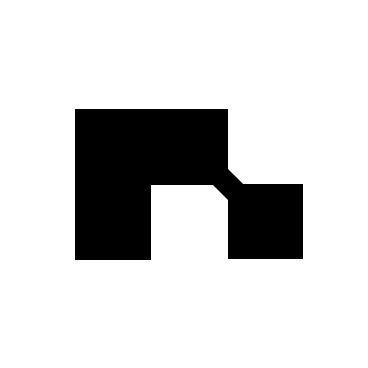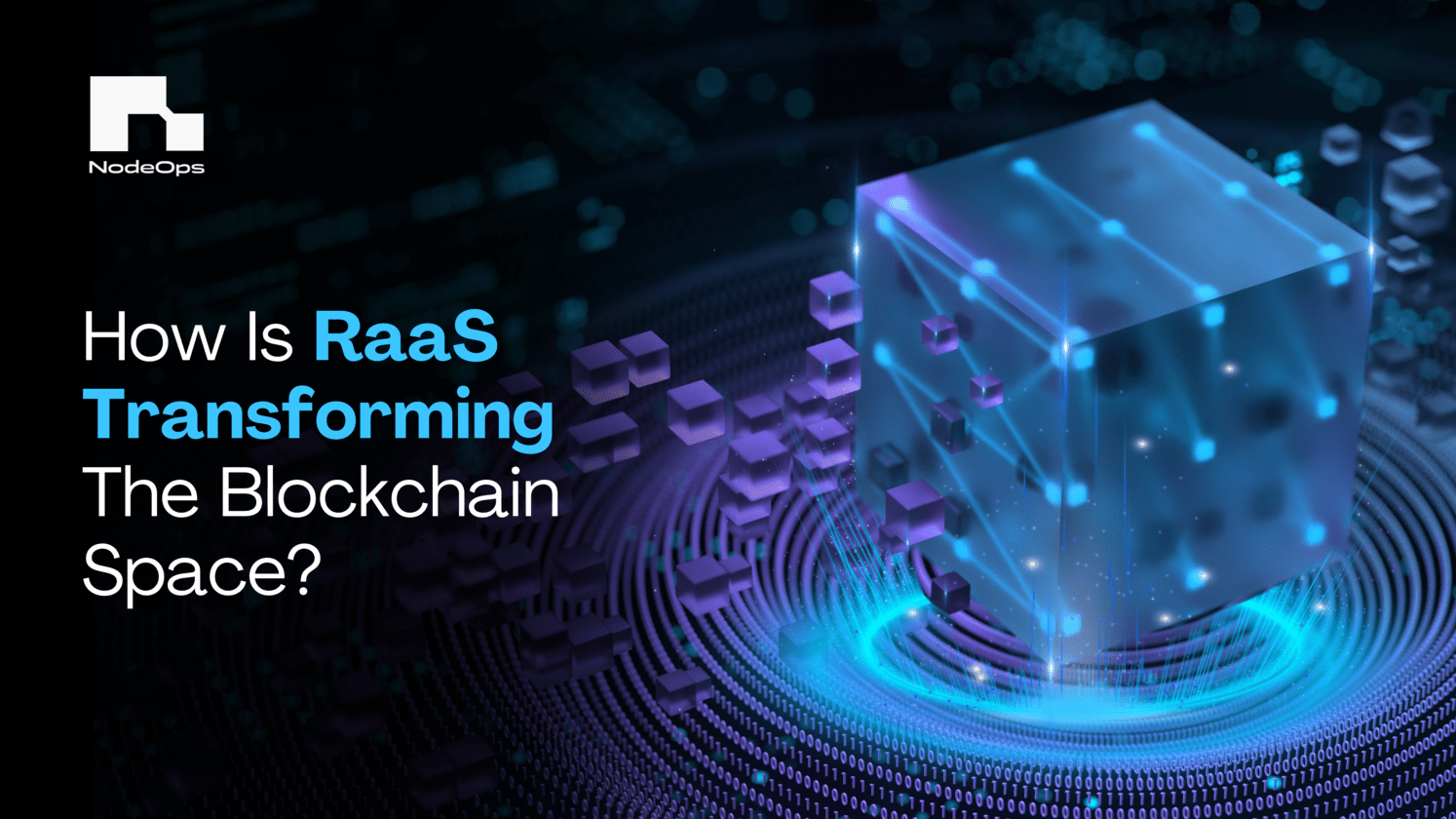How Is Rollup-as-a-Service (RaaS) Transforming The Blockchain Space?
 NodeOps
NodeOps
The Evolving Blockchain Space
The blockchain industry is continuously growing with solutions to tackle scalability, efficiency, and interoperability challenges. And as blockchain tech gains traction, its significance is hard to ignore. One of its hyped narratives right now is the emergence of rollups. This service is all set to play a role in the next wave of blockchain innovation, managing (if not solving) significant challenges and driving wider adoption. In this blog, we will discuss Rollup-as-a-Service (RaaS), exploring its types, importance, and operational mechanisms.
Understanding RaaS and its Types
We’re assuming you understand what rollups are to begin with. With that context, Rollup-as-a-Service is a user-adaptable framework that streamlines the execution and oversight of Layer-2 scaling solutions known as rollups, for networks.
Now that’s a lot of jargon. So here it is again, simplified:
A RaaS offers a platform for Web3 companies, dApp projects, and developers to efficiently develop, launch, and manage their rollup chains that target the scalability hurdles encountered by Layer-1 blockchains.
The RaaS platform introduces a layer of abstraction above the coding structure for launching rollups similar to Software as a Service (SaaS) products. This approach relieves users from handling hardware and software setups, simplifying deployment.
Developers can easily create rollup chains using features like configured elements, software development kits (SDKs), and templates. RaaS plays a crucial role in driving the growth and acceptance of technology.
Types of Rollups
RaaS has two main types of rollup solutions: Optimistic rollups and Zero-Knowledge (ZK) Rollups. Both methods boost scalability and efficiency, but they work differently.
- Optimistic Rollups
Optimistic Rollups treat transactions as valid by default. They handle off-chain transactions on a separate Layer-2 network, then send grouped transactions to the main Layer-1 blockchain. This process involves two parties. One puts the rolled-up transaction on the mainnet. Another party sends fraud-proofs if it detects any flawed or invalid transactions. Both parties stake tokens on the main network. If needed, these tokens help resolve any disputes that arise. However, the chances of invalid transactions are low in Optimistic Rollups due to their dual-validation system. OP Stack and Arbitrum Orbit are well-known Optimistic Rollup platforms.
- ZK-Rollups
ZK RaaS allows the implementation of ZK-Rollups for blockchains and AppChains. Unlike Optimistic Rollups, it does not provide a dispute resolution tool. Instead, they rely on Zero-Knowledge proofs, an advanced cryptographic technology. ZK-Rollups pack transactions with this cryptographic proof called SNARK (Succinct Non-Interactive Argument of Knowledge). It is then undertaken and confirmed by a contract on the main Layer-1 blockchain. The setup demands proof for transactions on the main network to speed things up and boost efficiency. Polygon CDK, StarkNet, and zkSync Era lead the ZK-Rollups network.
Perks of using RaaS
RaaS offers several advantages for organizations and companies looking to adopt blockchain technology, which are
Scalability: offers highly customizable scaling. The user can adapt to the changing demands and ensure the high performance of the apps.
Simplicity: streamlines complexity, reduces overheads, and allows streamlined processes. It focuses only on the essential data and transactions relevant to use cases.
Security: delivers commercial-grade secure blockchain infrastructure to build reliability and ensure the safety of transactions. The transactions on such platforms are predictable, which minimizes risks and improves trust.
NodeOps is at the forefront of this tech revolution, leveraging all its benefits. By partnering with leading RaaS providers, such as Lumoz, we’re streamlining the blockchain infrastructure, enabling developers to focus on building innovative apps. Lumoz offers Rollup-as-a-Service (RaaS), enabling developers to launch their own ZK-Rollups on the Mainnet. They are the leading provider of modular prover networks. Developers can benefit from this partnership while relying on NodeOps’ node deployment and operations expertise.
Working of the RaaS Platform
RaaS offers advanced features for Web3 developers to create and implement custom rollups. Here’s how the platform typically functions:
[

](https://substackcdn.com/image/fetch/f_auto,q_auto:good,fl_progressive:steep/https%3A%2F%2Fsubstack-post-media.s3.amazonaws.com%2Fpublic%2Fimages%2F59e90d32-f0b7-44d6-918e-f7964b4a68a5_1291x1025.png)
Source | Working of RaaS Platform
- Onboarding projects
Web3 projects can join a RaaS platform quickly and efficiently. They get a whole stack of SDKs, templates, and plug-and-play tools, which speed up their work.
- Customization
The platforms let projects tweak their rollup chains. They can change security settings, boost transaction speed, set fees, and adjust performance according to the project's needs.
- Integration
The system makes Rollups flexible by connecting with data layers, sequencers, and settlement systems. Users can build rollups using explorers, wallets, and account abstraction tools.
- Monitoring and maintenance
The platform monitors and fixes issues to optimize safe and secure performance, allowing developers to focus on their primary goals.
- Scaling and upgrades
As projects evolve, RaaS platforms expand to manage traffic, perform more transactions, and optimize speed.
Leveraging RaaS in Web3 Projects
- Apply to Layer-1 and Layer-2 networks
The rise of Bitcoin Layer-2 solutions and RaaS is promising and offers new opportunities for scalability and innovation within the evolving blockchain system. RaaS platforms allow Layer-1 blockchains to launch custom rollup chains quickly. Layer-2 networks can build rollup chains for specific applications, enhancing performance and customization.
- An alternative to AppChains
AppChains or application-specific blockchains are unique entities that manage large dApps in their ecosystem rather than sharing space with multiple dApps. Web3 projects can fire up rollup chains on RaaS platforms with high-end dev tools, plugins, and frameworks without the infrastructure or high-cost management hassle.
- Existing Web3 projects can add rollups
Web3 projects like gaming platforms, NFT marketplaces, and DeFi applications can switch to custom rollup chains built on RaaS. This transition fuels transaction speed and provides a secure infrastructure. Implementing rollups for these Web3 projects is effortless, and a ready-to-use stack, tools, and rollup SDKs are provided.
NodeOps enhances Web3 projects by collaborating with RaaS providers such as Lumoz to streamline the infrastructure for operators and developers, enabling them to deliver excellent operating solutions in the blockchain system.
The Bottomline on RaaS
Rollup-as-a-Service simplifies deployment of rollup solutions by minimizing technical complexities and making blockchain scalability accessible to Web3 businesses. Its applications span decentralized systems, gaming, supply chain, and more. RaaS offers users cost-effective and scalable transactions, making it a game-changer in the blockchain space.
NodeOps is the only node operator supporting almost all of the recent node infrastructures that raised more than 125 million via their Node Sales, including XAI, HyChain, Avail, Zora, and more, with over 30,000+ nodes powered by us in the last quarter alone. We currently support over 35+ chains and deliver single-stop node deployment solutions for node infrastructures and relevant communities.
Join NodeOps today and try out one-click node deployment across our supported protocols. Further, for protocol updates, follow NodeOps on X!
Subscribe to my newsletter
Read articles from NodeOps directly inside your inbox. Subscribe to the newsletter, and don't miss out.
Written by

